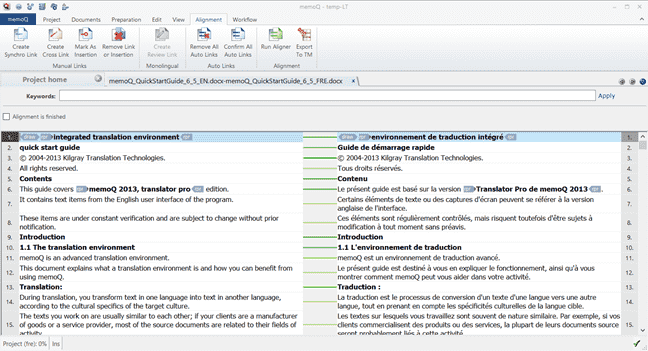This is the first of an occasional series where we interview memoQ users on how they use the software. In this post we talk to Susan Starling who is a financial translator working from German to English and living in the US of A.
Hello Susan, can you introduce yourself and explain what you do?
My name is Susan Starling and I’ve been a full-time German to English translator since 1997. Although originally from the East Coast of the United States, I moved to Berlin just one year before the wall fell and ended up spending the next 20+ years in Germany. During most of that time I worked as a freelance translator, except for a highly interesting three-year stint as senior translator at a boutique translation company in Frankfurt am Main.
What sort of translation work do you do?
Mostly corporate and financial translation. I was very lucky to start out with a company specialized in legal and financial texts, and I was found to have an odd knack for unravelling those dreadfully long, complex German legal sentences and transforming them into intelligible English. I admit I even enjoy such puzzles! Plus we had an excellent setup: every document I translated was reviewed by the senior partner before being sent to the client, and I would immediately receive the revised version of my work. This was absolutely invaluable and made me a fervent supporter of collaboration. I’ve learned so much more in all the years of working on teams and having colleagues edit my work than I ever could have on my own. This is why I see it as a problem in our business that so many translators work in isolation. Translators as a group probably tend to be somewhat introverted, which might hinder them in seeking opportunities for teamwork or peer review. But this is simply vital to improving as a translator, or even reaching an acceptable level of skill in the first place. Kevin Hendzel has written some excellent blog posts on the subject, including this one.
When did you first start using memoQ and why?
I first heard about memoQ in the summer of 2009 when I was attending a financial translators’ seminar in London and happened to be sitting next to Kevin Lossner one evening as he raved about a promising new tool on the market. At the time I was looking to upgrade from Trados Workbench and wasn’t sure which direction to take. Then, at the BDÜ conference that September in Berlin, I had an opportunity to chat with Kilgray’s István Lengyel about alignments, which are hugely important in financial translation, and I was intrigued by his hints of the LiveDocs feature yet to come. So I went ahead and purchased a memoQ license, but what really inspired me to start using it was the infectious enthusiasm of users at memoQFest in Budapest in 2010. And one little thing gave me the final push to switch: at the conference I learned how easy it was to add terms and maintain glossaries in memoQ. That really did it for me!
How is financial translation different from other types of translation?
Financial translation itself is an extremely broad field, and most translators specialize in quite different areas such as investment banking or financial accounting and reporting. In addition to monetary policy, banking regulation, etc., the bulk of the financial translation work I do consists of annual and interim reports, and these do have certain unique characteristics. I would say the main difference is that in the world of financial reporting, you cannot translate a document (or set of documents) as an isolated case. Your text always has to be seen in the context of that company’s other published reports, press releases and the like, all of which contain specific approved wording that has to be maintained from year to year and which differs from company to company. So it’s nearly impossible to do this type of translation properly without a powerful system for leveraging and referencing the company’s past published, bilingual material, i.e. by aligning texts, and this is where memoQ’s LiveDocs feature comes in.

You have talked in the past about LiveDocs. Which LiveDocs features do you like and how do you use them?
Before LiveDocs, text alignment in the common CAT tool was a very tedious process of preparing the original files and then doing the actual alignment. It used to take me 2-3 days to adequately prepare and align a 200-page annual report before I could start translating the current report. Multiply that by however many previous years or quarters need to be taken into account, plus any relevant legislation, and we’re talking about a lot of time! Kilgray has solved this ingeniously with LiveAlign, an alignment feature that lets you import unprepared documents that are then roughly aligned by the tool. The advantage of this is that after the rough alignment, any matches in the source text will show up in your translation workspace just like TM matches. Concordance searches also include the material in your project’s LiveDocs corpora. The alignment itself will often not match up correctly, but this is easy to fix “on-the-fly”: simply right-click the Concordance match from LiveDocs, or the LiveDocs match in the translation results pane (top right of the working window), to access the original document alignment, where you can correct misalignments without having to worry about the rest of the document that may not be relevant to your current translation.
But it gets better: the real advantage of LiveDocs compared to traditional translation memories is that TM matches only show one particular source segment and its translation; the surrounding context is completely neglected. With LiveDocs, however, whenever you have a Concordance hit you can right-click on it to view your segment in the context of the entire original document. We all know how important context is to proper translation, and I find it unfortunate that the no-context, TM-driven approach has become so entrenched in our industry, at least among the bulk market suppliers. This is a method that can only lead to increasingly unintelligible “translations,” as 100% matches that the translator is not even supposed to glance at, much less adapt to the surrounding material, are recycled again and again and reassembled in a different order or in different contexts as though translation were an exact science with interchangeable elements. So the context aspect is truly a gigantic benefit of LiveDocs.
Is there any functionality in memoQ that is particularly good for financial translators?
As a financial translator I would never again want to work without LiveDocs. Other than that, what delights me time and again is the automatic number insertion feature introduced a couple of years back. This means that if you have a source segment in your TM or in your LiveDocs corpus that is exactly the same as your current source segment except for the numerical figures, memoQ will automatically update the numbers and insert the segment; the translator doesn’t have to touch a thing.
Also, during financial reporting season, there are often multiple updates to a translation in progress. The “X-translate” feature is very helpful here because it allows pretranslation of a new version based on a specific previous version of the project document. In addition, the feature for importing changes made to target documents for the purpose of updating a project and its TM or its LiveDocs corpora (“Monolingual Review”) is a real help in maintaining data and avoiding the re-use of language that was supposed to be changed.
Autotranslatables for structured information such as dates or monetary expressions are also helpful to maintain consistency in a translation. I would like to see more examples of these made available by Kilgray.
If you could decide on one new feature in memoQ what would it be?
At this point, new features are much less important to me than solidifying the tool’s many existing strong features. A lot could be done to improve LiveDocs integration, particularly the confusion regarding its handling of language variants. Overall the way in which memoQ handles variants such as “generic” German and the languages of Germany, Austria, Switzerland, etc. is neither consistent nor intuitive when you compare how this works in LiveDocs, translation memories, and term bases.
We could also use further improvements in the management of light resources such as stopword lists and nontranslatables lists, and the terminology extraction features need to be extended and “denerdified.”
memoQ is an excellent, comprehensive tool for professionals, and a lot of benefit could be gained by improving the stability, maintenance, and integration of its fundamental features and by exploring new ways to take advantage of existing features – including simplifying workflows for collaborating with translators who use memoQ, other tools, or no translation environment tool at all.
To learn more about Susan, please visit www.susanstarling.com.

Peter Reynolds
memoQ co-CEO



